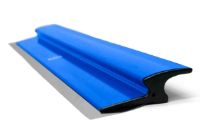Essential tools for drywall finishing for each Q level and degree of automation
Looking for the right tools to finish drywall? The abundance of options available on the market might seem a bit overwhelming at times. So which tools do you actually need to get a decent finishing job done?
It takes an artisan to do a proper drywall finishing job, there’s no question. But using the right tools can increase the number and quality of jobs you get done. There are different ways of working: fully or partially by hand or using automatic tools that enable you to work more quickly, easily, and with less physical strain. Drywall finishing comes in different Q or quality levels, depending on the level of smoothness required for the decorative layer that comes on top of the finished surface.
Something for everyone: Which drywall finishing tools are needed for each purpose?
Tools come in all shapes, sizes, and prices. And even when using more advanced or automatic tools, you will always need to keep hold of your manual tool set to finish small spaces and do touch-ups. The distinction between manual, semi-automatic, and fully automatic drywalling is not always very clear. While for some a banjo taper is manual, others call it an automatic tool; the same goes for flat boxes and other equipment. For an overview of the most essential tools, check out the lists below.
Tools for manual drywall finishing
For manual jobs, consider investing in the following tools:
- Knives
- Mud pans
- Flat/corner trowels
- Skimming blades
- Extension handles
You can buy manual tools individually, but also look into manual tool sets that offer a complete set in one. These tools enable you to finish surfaces up to Q level 4. Still, it goes without saying that for bigger projects with a larger surface, investing in more automated tools will pay off. So take the time to look into the opportunities that investing in one or more (semi-)automatic tools could bring.
Working semi-automatically
When you think about stepping away from purely manual finishing, you have several options. You can focus on making taping easier and invest in a banjo taper or even an automatic taper. The latter always comes with a loading pump. For wider joint covering tasks, flat boxes are very handy. If reducing physical strain and increasing speed of work is top of your wish list, a powered pump is an interesting investment to make.
Checklist for semi-automatic finishing:
- Taper (banjo)
- Automatic taping and finishing tools (ATF):
- Automatic taper
- Compound tubes
- Flat boxes
- Corner/angle boxes
- Nail spotters
- Manual loading pump or powered loading pump
The above tools are primarily helpful in automating Q1 and Q2 finishing jobs. For the Q3 and Q4 jobs, the way of working remains largely similar to the manual approach.
Upgrading to the automatic toolset
If you do a lot of larger Q1 and Q2 projects, are considering Q3 and Q4 level (up to skim coating) finishing, or are looking into expanding your business in that direction, it might be worthwile considering some extra equipment. Two kinds of tool are interesing for making your business substantially more automatic:
- A Continuous Flow System (CFS) allows you to tape and finish much more quickly and consistently than when working manually or semi-automatically, thanks to the continuous flow provided to your ATF tools. With a CFS, productivity can be boosted by 75%, while the physical strain is reduced dramatically. Also consider a CFS for large and frequent jobs up to Q2 level of finishing.
- Airless sprayers should be on your wish list if you want to finish large surfaces at a Q3 or Q4 level. These pumps can also be used for a Q2 finishing, so the investment has a wider payoff than only Q3 and Q4 projects.
related articles
Are automatic drywall finishing tools worth the investment?
What benefits can you expect from investing in automatic drywall finishing tools?
How to expand your drywall finishing contracting business
Feel like expanding your drywall finishing business? Look into some strategies to make it work.
3 reasons to invest in an automatic loading pump for drywall finishing
What are the three main reasons to invest in an automatic loading pump for drywall finishing?








